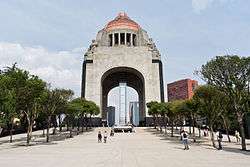Carlos Obregón Santacilia
Carlos Obregón Santacilia (1896–1961) was a Mexican art déco architect. He trained at the Academy of San Carlos during the Mexican Revolution. He claimed a distinguished Mexican heritage, as great grandson of Benito Juárez and grand nephew of Alvaro Obregón.[1]

Obregón saw the new architecture following the violent and destructive Mexican Revolution as the government's impulse to be constructive.[2] Among other works, Obregón Santacilia redesigned the building housing the Secretariat of Foreign Relations, at the request of Alberto J. Pani. The building went from a Louis XIV style structure to a neo-Colonial work, opened in 1924.[3] Minister of Public Education in the Obregón government, José Vasconcelos asked Obregón Santacilia to design a large primary school in Mexico City, to be built in "new nationalist perspective."[4] He also designed the new building for the Secretariat of Health and Welfare (1926), later decorated with murals by Diego Rivera.[5] He reworked the abandoned legislative palace of the Díaz era and transformed it to the Monumento a la Revolución, located in Mexico City.
Publications
- El Maquinismo, la Vida y la Arquitectura/Machines, Life, and Architecture. Cleveland: J.H. Jansen 1939.
- Cincuenta (50) Años de Arquitectura Mexicana (1900-1950). Mexico City: Editorial Patria 1952.
- El Monumento a la Revolución, Simbolismo e Historia. Mexico: Secretaria de Educación Pública, Departamento de Divulgación 1960.
Further reading
- Garay Arellano, Graciela de. La Obra de Carlos Obregón Santacilia, Arquitecto. Mexico City: Secretaría de Educación Pública, INBA 1982.
- Olsen, Patrice Elizabeth, Artifacts of Revolution: Architecture, Society, and Politics in Mexico City, 1920-1940. Lanham MD: Rowman & Littlefield 2008.
See also
References
- ↑ Patrice Elizabeth Olsen, Artifacts of Revolution: Architecture, Society, and Politics in Mexico City, 1920-1940. Lanham MD: Rowman & Littlefield 2008, p. 6
- ↑ Olsen, Artifacts of Revolution, p. 7.
- ↑ Olsen, Artifacts of Revolution, p. 8,
- ↑ Olsen, Artifacts of Revolution, p. 12.
- ↑ Olsen, Artifacts of Revolution, pp. 16-17.